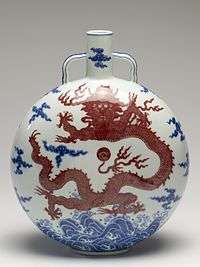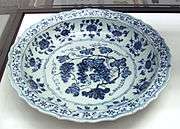Canton porcelain
Canton or Cantonese porcelain is the characteristic style of ceramic ware decorated in Guangzhou, the capital of Guangdong and (prior to 1842) the sole legal port for export of Chinese goods to Europe. As such, it was one of the major forms of exportware produced in China in the 18th and 20th centuries.
| Canton porcelain | |||||||
|---|---|---|---|---|---|---|---|
| Traditional Chinese | 廣州彩瓷 | ||||||
| Simplified Chinese | 广州彩瓷 | ||||||
| Literal meaning | Guangzhou colored porcelain | ||||||
| |||||||
| Guangcai | |||||||
| Traditional Chinese | 廣彩 | ||||||
| Simplified Chinese | 广彩 | ||||||
| Literal meaning | GZ color | ||||||
| |||||||
History
Typically, the exportware was made, glazed, and fired at Jingdezhen but decorated with enamels in Guangzhou (then usually romanized as Canton) for export to the west via the Thirteen Factories of the Canton System.[1][2][3] Canton famille rose in the 19th century was typically decorated with figures and birds, flowers and insects, predominantly in pink and green.[2]
The decorative famille rose patterns used in export wares may be called Rose Canton which is decorated with flowers, birds and insects but with no human figures; Rose Mandarin with human figures as the main subject and introduced in the late 18th century; and Rose Medallion which has different panels that may be of different subjects and introduced in the 19th century.[4]
See also
- Cantonese culture
References
- Nilsson, Jan-Erik. "Qing Dynasty (1644–1912) Porcelain". www.gotheborg.com. Jan-Erik Nilsson. Retrieved 6 January 2015.
- Valenstein, Suzanne G (1989). "A handbook of Chinese ceramics". www.metmuseum.org. Metropolitan Museum of Art. Retrieved 11 June 2016.
- Kjellberg, Sven T. (1975). Svenska ostindiska compagnierna 1731–1813: kryddor, te, porslin, siden [The Swedish East India company 1731–1813: spice, tea, porcelain, silk] (in Swedish) (2 ed.). Malmö: Allhem. pp. 226–230. ISBN 91-7004-058-3. SELIBR 107047.
- Mascarelli, Gloria; Mascarelli, Robert (1992). Warman's Oriental Antiques. Wallace-Homestead Book Company. p. 42–46.
External links
![]()


.jpg)